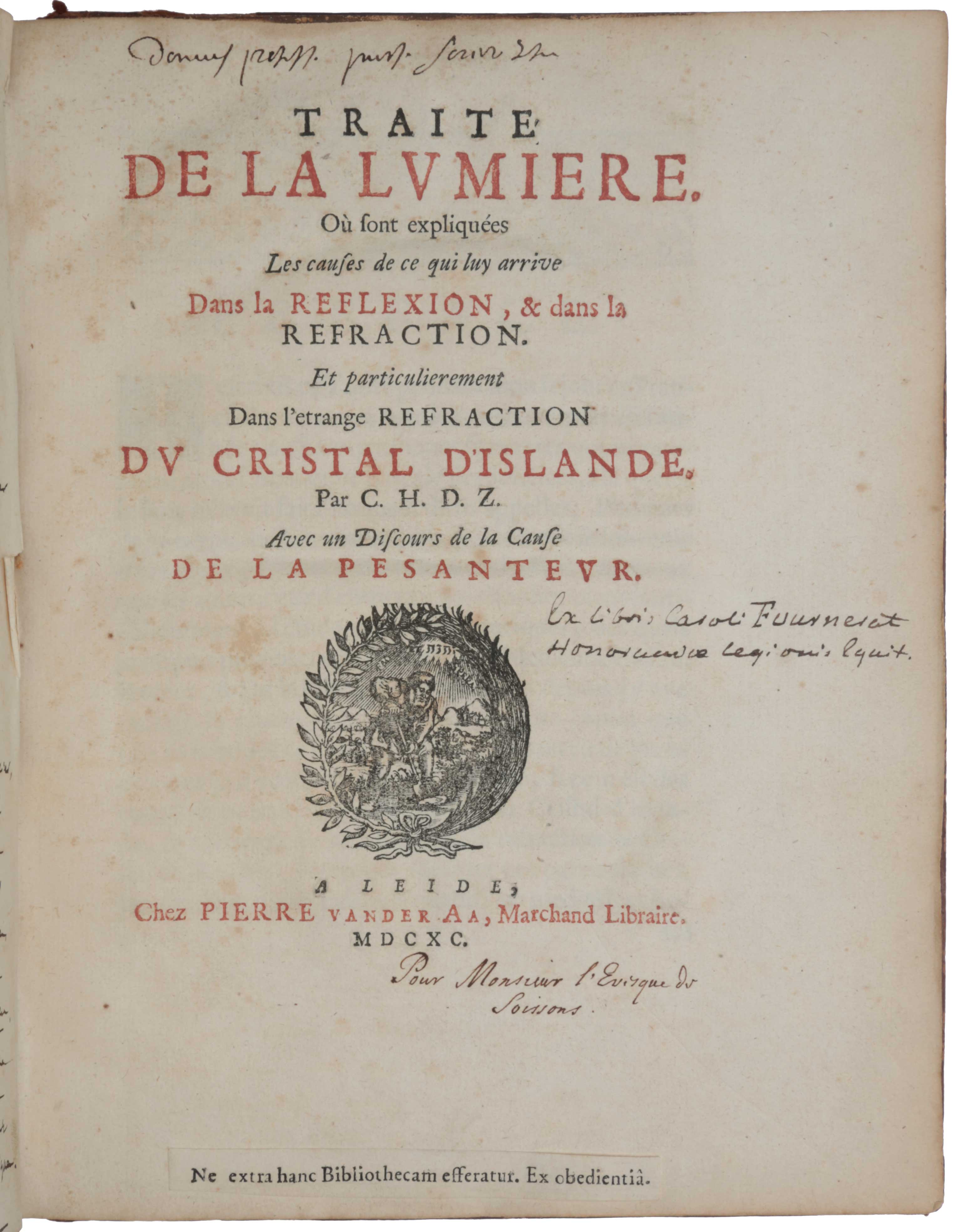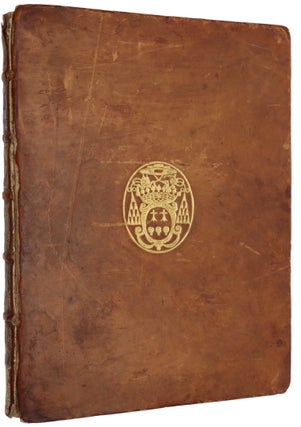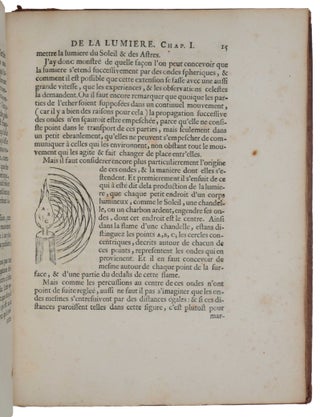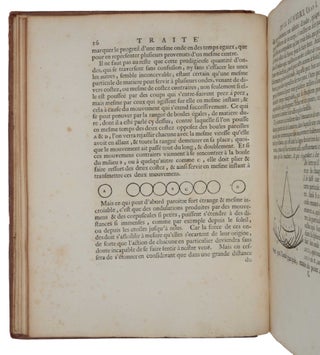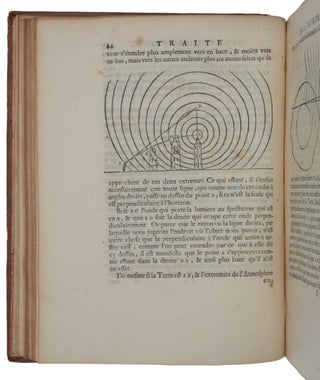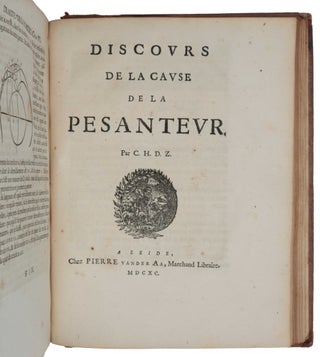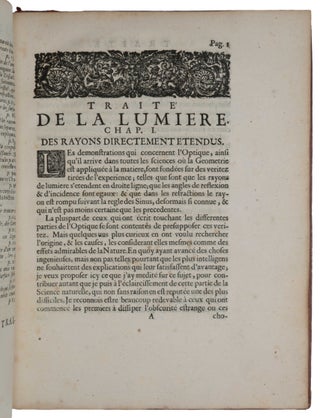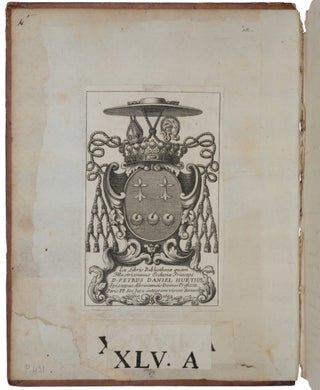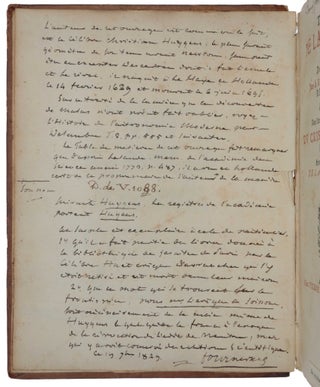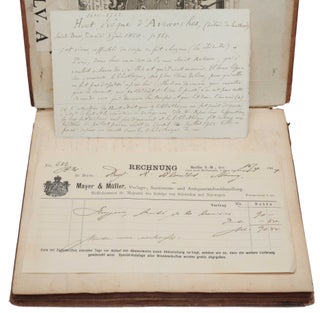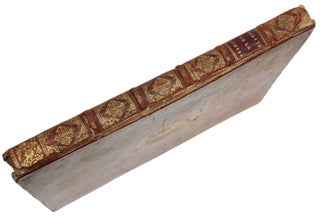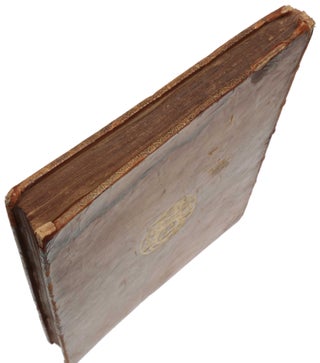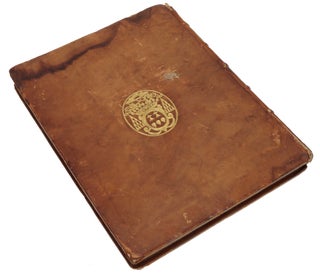Traité de la lumière. Ou sont expliquées les causes de ce qui luy arrive dans la reflexion, & dans le refraction, et particulièrement, dans l’étrange refraction du cristal d’Islande … Avec un discours de la cause de la pesanteur.
Leiden: Pieter van der Aa, 1690. First edition, first issue, of Huygens’ path-breaking exposition of his wave theory of light; this is an extremely rare large paper presentation copy inscribed by Huygens to Pierre Daniel Huet. Huygens had developed his theory of light in 1676 and 1677, and “completed the Traité in 1678, but left it unpublished for twelve years, until stimulated by the appearance of Isaac Newton’s Principia(1687) and by a visit with Newton in 1689. Huygens conceived of light as an irregular series of shock waves or pulses proceeding with very great but finite velocity through the ether, a medium consisting of uniformly minute, elastic particles pressed closely together. Using the ether as the medium of light wave propagation, he showed that all points of a wave front originate partial waves, and thereby generate further wave motion; light, therefore, consists not of a transference of matter, but rather of a ‘tendency to move’” (historyofinformation.com). Huygens was able to explain reflection and refraction using this theory, of which he became completely convinced in August, 1677, when he found that it explained the double refraction in Iceland spar. But he could not explain the phenomenon of polarization, which he discovered. In the second part of the work, the Discours de la cause de la pesanteur, written in 1669, Huygens expounded his vortex theory of gravity, a purely mechanistic theory that contrasted markedly with Newton’s notion of a universal attracting force intrinsic to matter. Indeed, Huygens added to the original treatise of 1669 a review of Newton’s theory, rejecting it out of hand because of the impossibility of explaining it by any mechanical principle or law of motion. Huygens’ work fell into oblivion during the following century, but his theory of light was confirmed at the beginning of the 19th century by Thomas Young, who used it to explain optical interference, and by Jean-Augustin Fresnel a few years later. Modern quantum physics has reconciled Newton’s and Huygens’ theories in discerning both corpuscular and wave characteristics in the properties of light. There are two issues of the Traité, one with the author’s initials ‘C. H. S. Z.’ on the title, identified by Norman as the probable first issue, and another with Huygens’ name in full on the title. Most of the large paper presentation copies, including ours as well as those of Horblit and Norman and those given by Huygens to Newton and Locke, are in the first state. ABPC/RBH lists three large paper presentation copies of the first issue: Christie’s New York, 9 June 1999, $74,000 (Honeyman); Christie’s New York, 10 December 1999, $101,500; Sotheby’s New York, 11 January 2001, $115,750 (Norman/Freilich). The Horblit copy of the first issue, presented to Locke, was not inscribed by Huygens himself. The Macclesfield large paper copy was of the second issue and was not inscribed. Provenance: Presented by Christiaan Huygens to Pierre Daniel Huet (1630-1721), French churchman and scholar (presentation inscription on title in Huygens’ hand, ‘Pour Monsieur L’Evisque de Soissons’, bookplate of Huet on front pastedown and matching gilt medallions of Huet showing bishop’s mitre on both boards). Huygens’ handwriting conforms to other examples of his presentation inscriptions and has been confirmed by the curator of the Huygens archive; purchased in 1764 by King Louis XV of France; Charles Fournerat (1780-1867), French politician (inscription on title ‘Ex libris Caroli Fournerat’ and full page of notes on the book written and signed by Fournerat on recto of front free endpaper); purchased in 1904 by Prosper-René Blondlot (1849-1930), French physicist (invoice of antiquarian book dealer Mayer & Müller, Berlin). “Light, according to Huygens, is an irregular series of shock waves which proceeds with very great, but finite, velocity through the ether. This ether consists of uniformly minute, elastic particles compressed very close together. Light, therefore, is not an actual transference of matter but rather of a ‘tendency to move,’ a serial displacement similar to a collision which proceeds through a row of balls. Because the particles of the ether lie not in rows but irregularly, a colliding particle will transfer its tendency to move to all those particles which it touches in the direction of its motion. Huygens therefore concluded that new wave-fronts originate around each particle that is touched by light and extend outward from the particle in the form of hemispheres. Single wave-fronts originating at single points are infinitely feeble; but where infinitely many of these fronts overlap, there is light – that is, on the envelope of the fronts of the individual particles. This is ‘Huygens’ principle’. “About 1676 Huygens found the explanation of reflection and refraction by means of this principle; his theory connected the index of refraction with the velocities of light in different media. He became completely convinced of the value of his principle on 6 August 1677, when he found the explanation of the double refraction in Iceland spar by means of his wave theory … “Although the completeness of Huygen’s analysis is impressive, he was unable to comprehend the effect that we now recognize as polarization, which occurs if the refracted ray is directed through a second crystal of which the orientation is varied. Huygens described this effect in his first studies on the crystal, but he could never explain it. These results are included in the Traité de la lumiére, which was completed in 1678; Huygens read parts of it to the Academy in 1679” (DSB). Huygens’ “entire theory is actually devoted to the description of the motion of a pulse through elastic media. Since such a kinematic approach would hardly be conceivable without a finite speed of propagation, Huygens opens the Traité by presenting Roemer’s observations establishing a finite speed of light and rejecting Descartes’ ‘incomprehensible’ view that it is infinite. He proceeds to construct what appears to be a conventional billiard-ball model of the aether, but the model gradually vanishes and only the kinematic requirements remain. Drawing upon his earlier investigations of impact, Huygens sets just a single condition upon the aether for it to serve for the propagation of light, namely, that it consists of elastic particles. He is then able to show that the velocity of light will be finite and uniform (or independent of the strength of the source) and that the principle of superposition will hold, for in collisions of elastic bodies ‘one and the same particles of matter can serve for many waves coming from different directions.’ Huygens then uses his billiard-ball aether to motivate his most brilliant contribution to optics, ‘Huygens’ principle’ … [which] consist of three assumptions: (i) each point of the wave front is the centre of particular waves; (ii) the wave front is determined by the common tangent to the extremities of these wavelets; (iii) the particular waves are perceptible only at their common tangent. All this is kinematically equivalent to defining a wave-front as the locus of points reached by a disturbance in a given time. This concept is the culmination of 17th-century attempts, beginning with Hobbes and proceeding through Hooke, Pardies and Ango, to describe the motion of a pulse or wave through optical media … “In the remainder of the work Huygens applies the principles laid down in the opening chapter to explain phenomena of increasing complexity. He first treats the elementary problems of reflection and refraction of plane waves at plane surfaces, and then refraction in inhomogeneous media such as the atmosphere. In the final two chapters he moves to the level of sophisticated mathematical physics. In the last chapter he elegantly solves the problem of the relation of the wave theory to geometrical optics by means of the mathematics of evolutes and involutes and relates the solution to the caustic. These results were at the forefront of contemporary mathematical physics. To explain the two refractions of Iceland crystal – the one obeying the ordinary laws of refraction and the other behaving in a totally extraordinary way – he assumed that two sets of particular waves were generated: one the usual spherical waves and the other spheroidal. From experiment he was able to determine the parameters and orientation of the spheroids. He then presented experimental confirmation including one prediction of a previously unknown phenomenon. Huygens referred to his explanation of double refraction as his experimentum crucis, and in an historical sense it was. The concept of particular waves could be confirmed only in double refraction, for all of the other phenomena treated by Huygens could be explained otherwise. Everyone who accepted ‘Huygens’ principle’ did so because of his experimentum crucis, and even Newton, who rejected Huygens’ theory, knew that he had to launch a direct attack on double refraction … “One key to Huygens’ success was the limited range of phenomena that he attempted to explain. He did not treat diffraction, interference, colour, or even polarisation, which he had discovered. Huygens was able to overcome the rampant conjectural aspect of Cartesian natural philosophy while remaining loyal to the mechanical philosophy by basing his theory on general hypotheses that were mathematically and experimentally tractable, and independent of the invisible structure of matter” (Shapiro, pp. 230-2). “Huygens’ explanation of gravity developed the ideas of Descartes. He presupposed a vortex of particles of subtler matter to be circling the earth with great velocity. Because of their circular movement these particles have a tendency (conatus) to move away from the earth’s center. They can follow this tendency if ordinary bodies in the vortex move toward the center. The centrifugal tendency of the vortex particles thus causes a centripetal tendency in ordinary bodies, and this latter tendency is gravity. The space which a body of matter vacates, under the influence of gravity, can be taken by an equal quantity of subtle matter. Hence the gravity of a body is equal to the centrifugal conatus of an equal quantity of subtle matter moving very rapidly around the earth. “This argument led Huygens to study centrifugal force in 1659. In his investigations he proved the similarity of the centrifugal and the gravitational conatus, a result that strengthened his conviction of the validity of the vortex theory of gravity. The study also enabled him to work out this theory quantitatively, since given the radius of the earth and the acceleration of gravity he could calculate the velocity of the particles; he found that they circle the earth about seventeen times in twenty-four hours. “Huygens developed this theory further in a treatise presented to the Academy in 1669. Since the cylindrically symmetrical vortices posited by Descartes could explain only gravity toward the axis, Huygens imagined a multilaterally moving vortex – in which the particles circle the earth in all directions – by which a truly centrally directed gravity could be explained. The particles are forced into circular paths because the vortex is held within a sphere enveloping the earth, and bounded by ‘Other bodies,’ such that the particles cannot leave this space. The boundary of the gravitational vortex was supposed to be somewhere between the earth and the moon, because Huygens thought the moon to be carried around the earth by a uniaxial vortex (the so-called vortex deferent). Later, convinced by Newton of the impossibility of such vortices, he supposed the gravity vortex to extend beyond the moon. “Galileo’s law of falling bodies requires that the acceleration which a falling body acquires in a unit of time be independent of the velocity of the body. This independence is the greatest obstacle for any mechanistic explanation of gravity, for the accelerations must be acquired during collisions, but the change of velocity of colliding bodies is dependent on their relative velocities. On this problem Huygens argued that, because the velocity of the vortex particles is very great with respect to the velocity of the falling body, their relative velocity can be considered constant. Thus, in effect he argued that Galileo’s law of falling bodies holds only approximately for small velocities of the falling body. “Huygens never discussed the fundamental question raised by this explanation of gravity – namely, how, by means of collisions, a centrifugal tendency of the particles of the subtle matter can transfer a centripetal tendency to heavy bodies. “In the Discours, the treatise of 1669 is reiterated almost verbatim, but Huygens added a review of Newton’s theory of gravitation, which caused him to revise his own theories somewhat. He resolutely rejected Newton’s notion of universal attraction, because, as he said, he believed it to be obvious that the cause of such an attraction cannot be explained by any mechanical principle of law of motion. But he was convinced by Newton of the impossibility of the vortices deferentes, and he accepted Newton’s explanation of the motion of satellites and planets by a force varying inversely with the square of the distance from the central body. According to Huygens, however, this gravity is also caused by a vortex, although he did not dwell on the explanation of its dependence on the distance” (DSB). Shapiro suggests that the Traité was published in the vernacular, rather than in Latin like most of Huygens’ other books and papers, because he regarded it as an incomplete or imperfect work, owing to his inability to account for the phenomenon of polarization. This may also explain why Huygens’ full name does not appear on the first issue. Newton adopted the same strategy (copied from Huygens?) in his Opticks (1704) – a work also first published in the vernacular and on which his name does not appear. This copy was presented by Huygens to Pierre Daniel Huet, French scholar, antiquary, scientist, and bishop whose incisive scepticism, particularly as embodied in his cogent attacks on René Descartes, greatly influenced contemporary philosophers. After studying mathematics with the Jesuits, Huet visited the court of Queen Christina of Sweden in 1652. From 1670 Huet assisted the French bishop Jacques Bossuet, tutor to the dauphin Louis, son of Louis XIV. He took holy orders in 1676 and served as bishop of Soissons Avranches for 10 years (1689–99) before retiring to the abbey of Fontenay, near Caen. In addition to scientific work in the fields of astronomy, anatomy, and mathematics, Huet wrote a number of philosophical works that asserted the fallibility of human reason, in which he attempted to refute such Cartesian first principles as “Cogito ergo sum” (“I think, therefore I am”) and the “clear and distinct” test for the truth of an idea. Huygens and Huet were acquainted and corresponded with each other over the course of their lifetimes. Huygens presented a copy of his Systema Saturnium (1659) to Huet, thus initiating a long intellectual friendship. Although Huet was not a member of the Jesuit order, he lived his final years in a Jesuit home in Paris. After his death, he bequeathed his library to the Jesuits and upon the dissolution of the order in France in 1764, the library was purchased by King Louis XV for the Royal Library. The volume was presumably dispersed during the French Revolution and was acquired by the French politician and bibliophile Charles Fournerat (1780-1867). It is no. 335 in the Catalogue de la Bibliotheque de feu M. Fournerat, Ancien Député de Nantes et Ancien Magistrat, Librairie Bachelin-Deflorenne, Paris, 1868. The sale began on 22 October and lasted eight days. In 1904 the book came into the hands of Prosper-René Blondlot, a physicist at the University of Nancy, who in 1891 made the first measurement of the speed of radio waves, but is now mostly remembered for his ‘discovery’ of ‘N-rays’ (N for Nancy), a phenomenon that subsequently proved to be illusory and which has been used ever since as a cautionary tale of how easy it is to deceive oneself into seeing something that is not really there. Dibner 145; Horblit 54; Norman 1139; Sparrow 111; Evans 32; En français dans le texte 25. Shapiro, ‘Huygens’ ‘Traité de la Lumière’ and Newton’s ‘Opticks’: pursuing and eschewing hypotheses,’ Notes and Records of the Royal Society of London 43 (1989), pp. 223-247. Shelford, Transforming the Republic of Letters: Pierre-Daniel Huet and European Intellectual Life, 1650-1720, 2007.
4to (230 x 184mm), pp. [viii], 124, [2], 125-128, [2], 129-180, general title printed in red and black, woodcut device on both titles, 89 woodcut diagrams in the text (scattered light foxing). Contemporary calf with Huet’s coat-of-arms stamped in gilt on both boards, raised bands, elaborately gilt-decorated spine with red leather label (upper joint cracked but holding; stain at top of rear board, general scuffing to boards). Custom full leather box. A very good copy, entirely unrestored.
Item #5928
Price: $250,000.00

